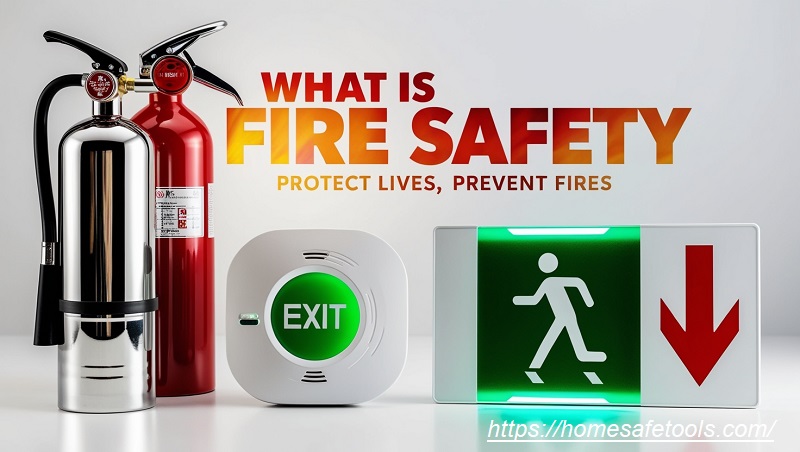Fire safety refers to a set of practices and measures designed to prevent the occurrence of fires, reduce their impact, and ensure the safety of individuals, property, and the environment. It encompasses fire prevention strategies, fire response planning, and the implementation of protective systems and equipment. What is Fire Safety?
Fire safety is critical in homes, workplaces, and public spaces. Understanding fire safety principles can save lives, minimize property damage, and reduce economic losses. Homesafetools.com will provide an in-depth look into fire safety, its importance, essential elements, and best practices.
Why is Fire Safety Important?
Fires are a major hazard that can occur unexpectedly. Without proper safety measures, they can lead to devastating consequences, including:
- Loss of Lives: Fires pose significant risks to human life.
- Property Damage: Fires can destroy homes, workplaces, and valuable assets.
- Environmental Impact: Wildfires, for example, can devastate ecosystems and contribute to air pollution.
- Economic Costs: Recovery from fire incidents can be expensive, including rebuilding, medical costs, and business disruptions.
Implementing fire safety measures helps mitigate these risks and ensures that individuals and organizations are prepared to respond effectively in case of a fire.

Key Elements of Fire Safety
Fire safety can be categorized into three main areas: prevention, protection, and preparedness.
1. Fire Prevention
Fire prevention focuses on reducing the likelihood of a fire starting. This includes:
Eliminating Hazards:
- Avoiding the accumulation of flammable materials.
- Properly storing hazardous substances.
- Maintaining electrical systems to prevent short circuits.
Education:
- Training individuals about safe practices, such as proper handling of fire-prone materials.
- Teaching the dangers of leaving cooking unattended.
Inspection and Maintenance:
- Regularly inspecting fire-prone equipment (e.g., heaters, wiring).
- Ensuring compliance with fire codes and regulations.
2. Fire Protection
Fire protection involves installing systems and equipment to control or extinguish fires and protect occupants. Key components include:
Fire Alarms:
- Detect smoke or heat and alert occupants to evacuate.
Sprinkler Systems:
- Automatically release water to suppress flames.
Fire Extinguishers:
- Portable devices used to tackle small fires before they spread.
Fireproof Materials:
- Using fire-resistant construction materials to slow the spread of fire.
3. Fire Preparedness
Preparedness ensures individuals and organizations know how to respond to a fire effectively. It includes:
Fire Drills:
- Practicing evacuation procedures regularly.
Emergency Plans:
- Developing and communicating plans for escape routes and meeting points.
Training:
- Teaching individuals how to use fire extinguishers and recognize fire alarm signals.
Types of Fires and Fire Safety Measures
Understanding the types of fires helps determine the appropriate safety measures and extinguishing methods:
Class A Fires: Combustible materials like wood, paper, and cloth.
- Extinguishing Method: Use water or foam extinguishers.
Class B Fires: Flammable liquids like gasoline, oil, and alcohol.
- Extinguishing Method: Use foam, carbon dioxide, or dry chemical extinguishers.
Class C Fires: Electrical fires involving appliances, wiring, or equipment.
- Extinguishing Method: Use dry chemical or carbon dioxide extinguishers (never water).
Class D Fires: Combustible metals like magnesium or sodium.
- Extinguishing Method: Use dry powder extinguishers designed for metal fires.
Class K Fires: Cooking oils and fats, common in kitchens.
- Extinguishing Method: Use wet chemical extinguishers.
Fire Safety in Different Environments
1. Fire Safety at Home
- Smoke Alarms: Install and regularly test smoke detectors.
- Kitchen Safety: Avoid leaving cooking unattended. Keep a fire extinguisher in the kitchen.
- Electrical Safety: Avoid overloading outlets and replace damaged wires.
- Escape Plans: Establish clear evacuation routes and practice them with family members.
2. Fire Safety at Work
- Fire Drills: Conduct regular drills to ensure employees are familiar with evacuation procedures.
- Fire Exits: Ensure exits are clearly marked and unobstructed.
- Fire Extinguishers: Place extinguishers in accessible locations and train employees on their use.
3. Fire Safety in Public Spaces
- Compliance with Codes: Ensure buildings adhere to local fire safety regulations.
- Crowd Management: Train staff to manage evacuations during emergencies.
- Emergency Lighting: Install backup lighting for safe evacuation during power outages.
Fire Safety Equipment and Tools
Having the right equipment can significantly improve fire safety:
- Smoke Detectors: Early warning systems that detect smoke and alert occupants.
- Fire Extinguishers: Different types are available for specific classes of fires.
- Fire Blankets: Used to smother small fires or protect individuals from flames.
- Emergency Exits: Clearly marked and easily accessible escape routes.
- Fire Suppression Systems: Automatic systems like sprinklers that control or extinguish fires.
- Fireproof Safes: Secure storage for important documents and valuables.
Best Practices for Fire Safety
- Educate and Train: Conduct regular fire safety training sessions for family, employees, or tenants.
- Inspect and Maintain: Schedule regular inspections for fire alarms, extinguishers, and electrical systems.
- Follow Fire Codes: Adhere to local building and fire safety regulations.
- Stay Alert: Be vigilant about potential fire hazards, especially in high-risk areas like kitchens and workshops.
What to Do During a Fire
- Raise the Alarm: Alert others by activating fire alarms or shouting for help.
- Evacuate Immediately: Use designated escape routes and avoid using elevators.
- Stay Low: Crawl if there’s heavy smoke to avoid inhaling toxic fumes.
- Call Emergency Services: Once safe, dial your local emergency number.
- Do Not Re-Enter: Never return to a burning building for belongings.
- Fire Safety Regulations and Standards
Fire safety regulations vary by country but generally include:
- Building Codes: Requirements for fire-resistant materials, fire exits, and alarm systems.
- Occupational Safety Standards: Guidelines for workplace fire safety, such as OSHA standards in the U.S.
- Fire Drills: Mandatory evacuation drills to prepare occupants for emergencies.
Conclusion
Fire safety is a vital practice that combines prevention, protection, and preparedness to minimize the risks associated with fires. Whether at home, work, or in public spaces, understanding fire safety principles and implementing the right measures can save lives, protect property, and reduce environmental damage. By staying informed and prepared, you can ensure a safer environment for yourself and others.
